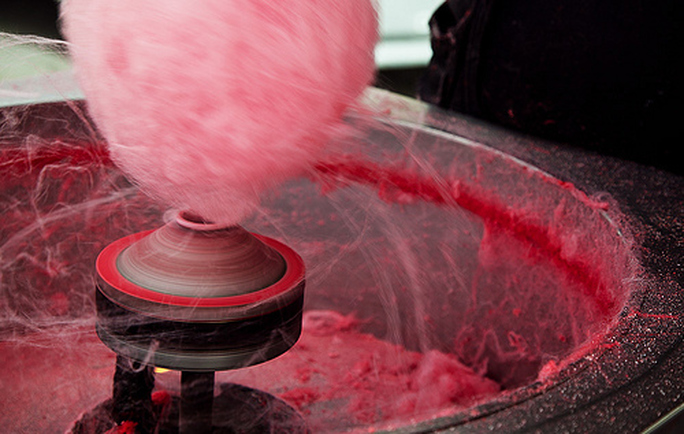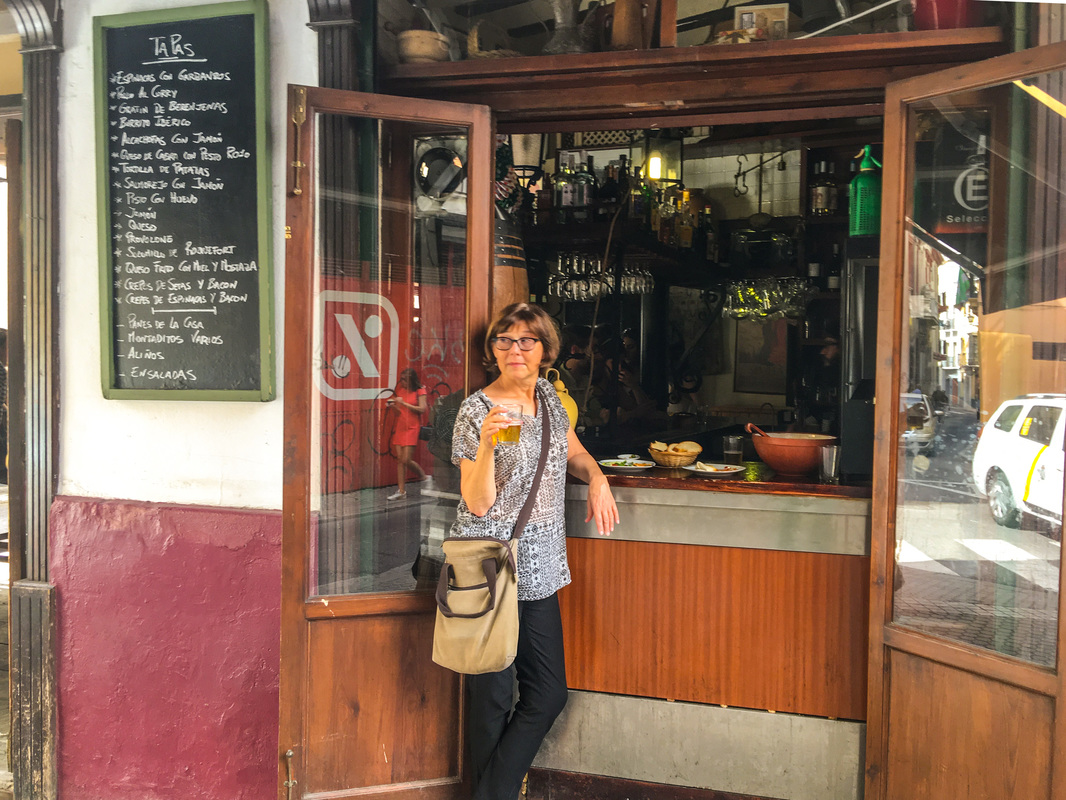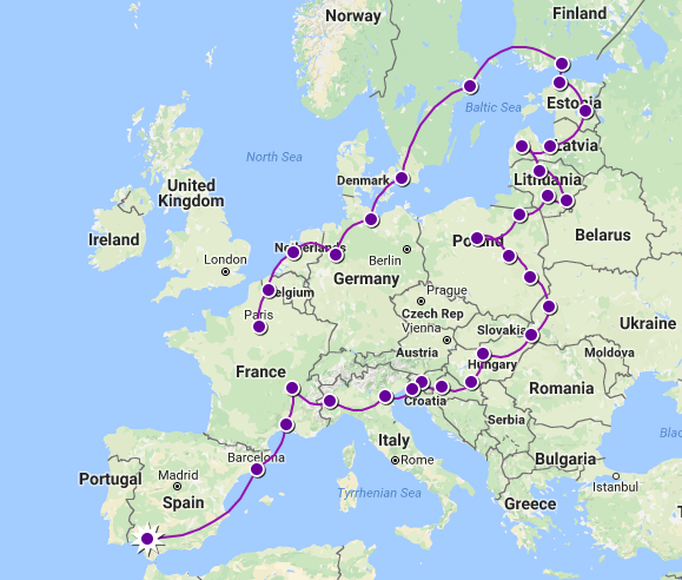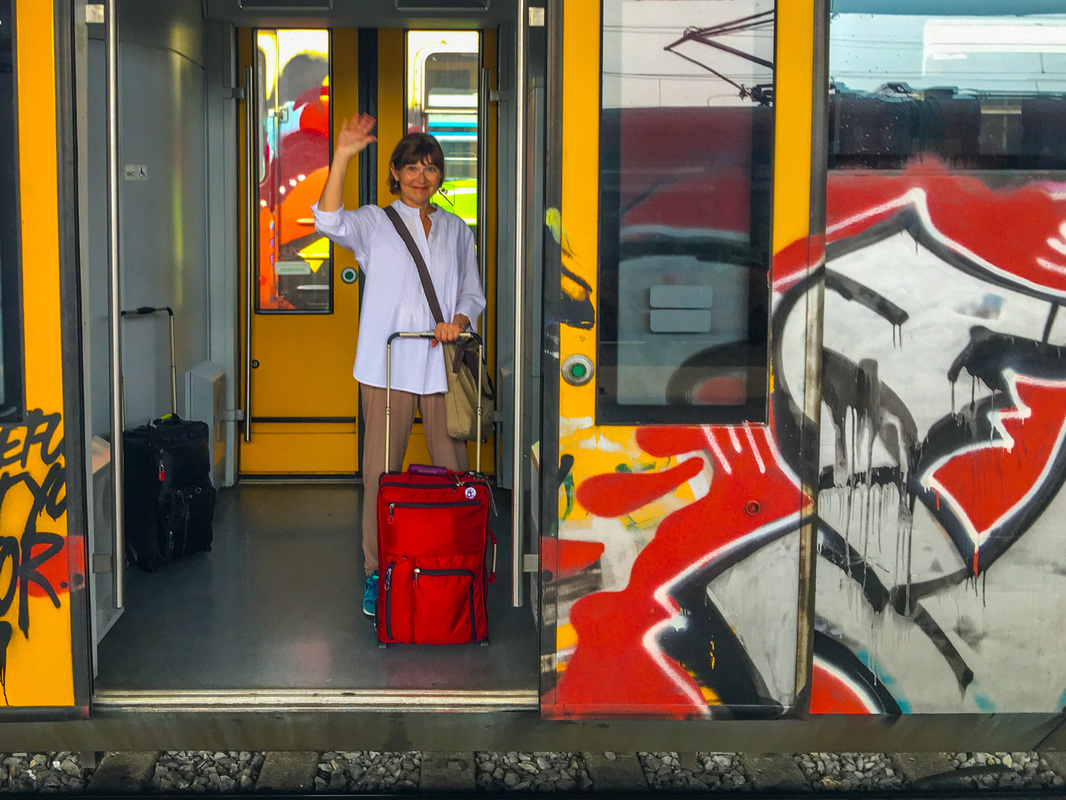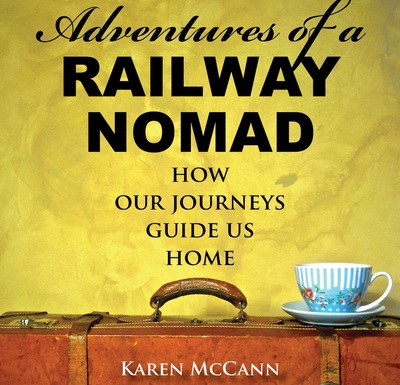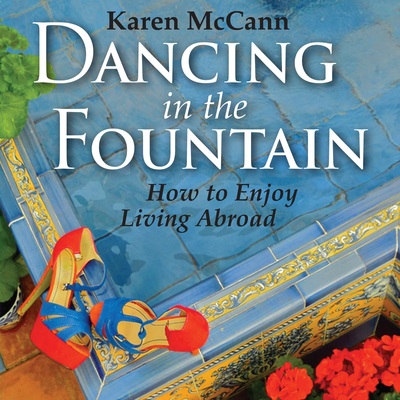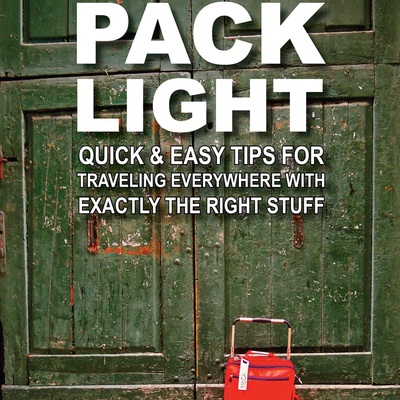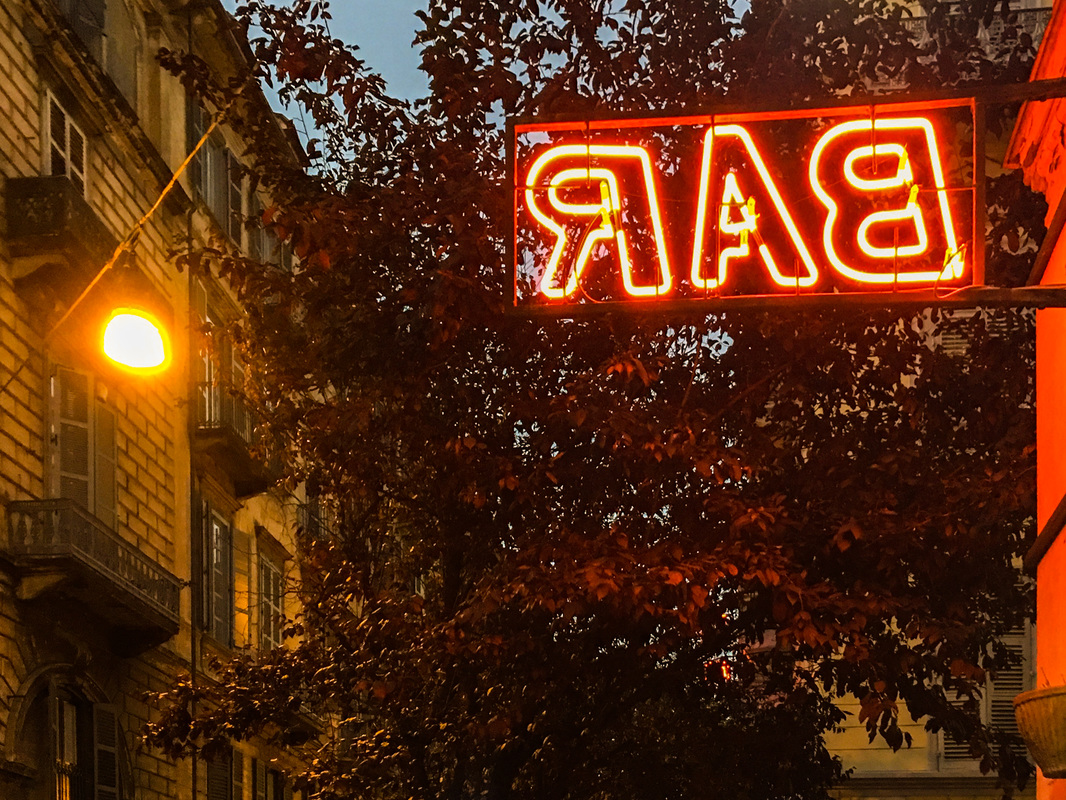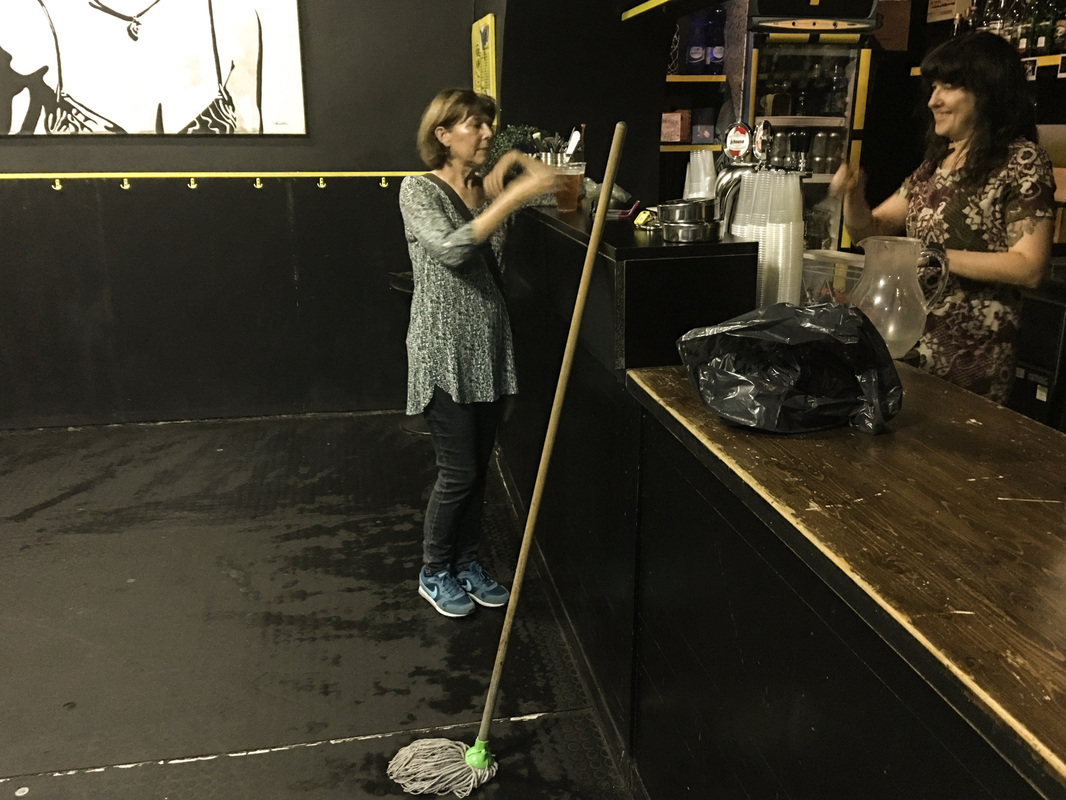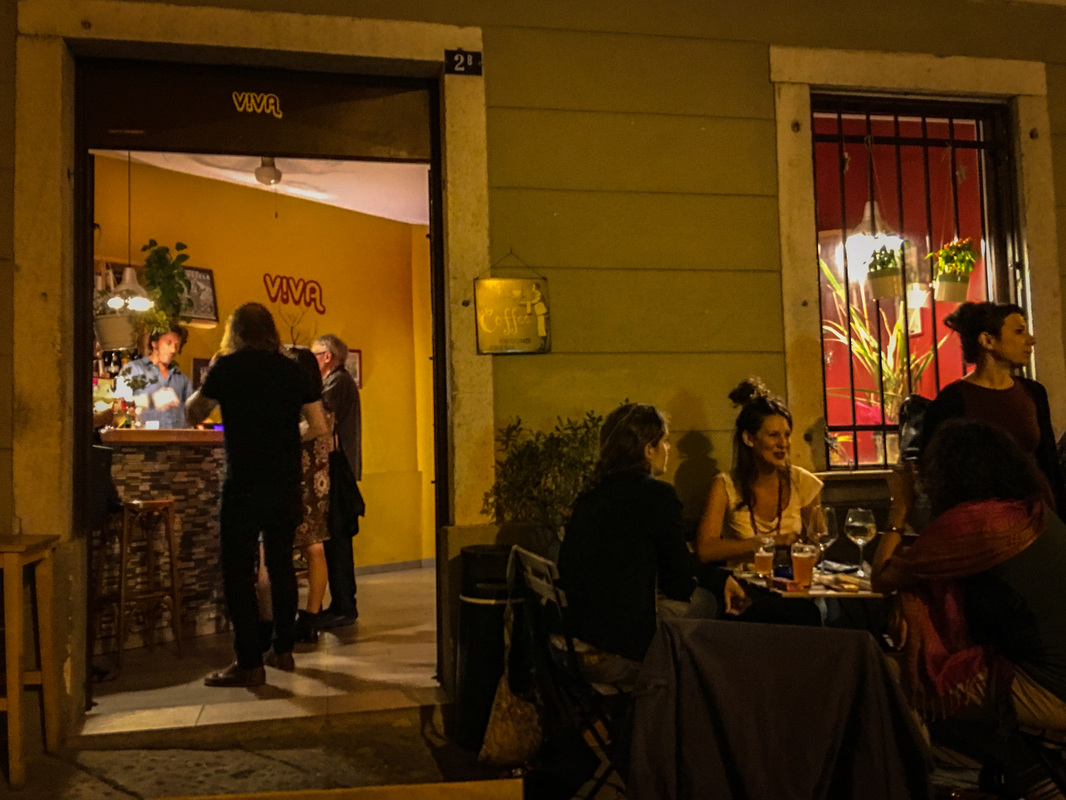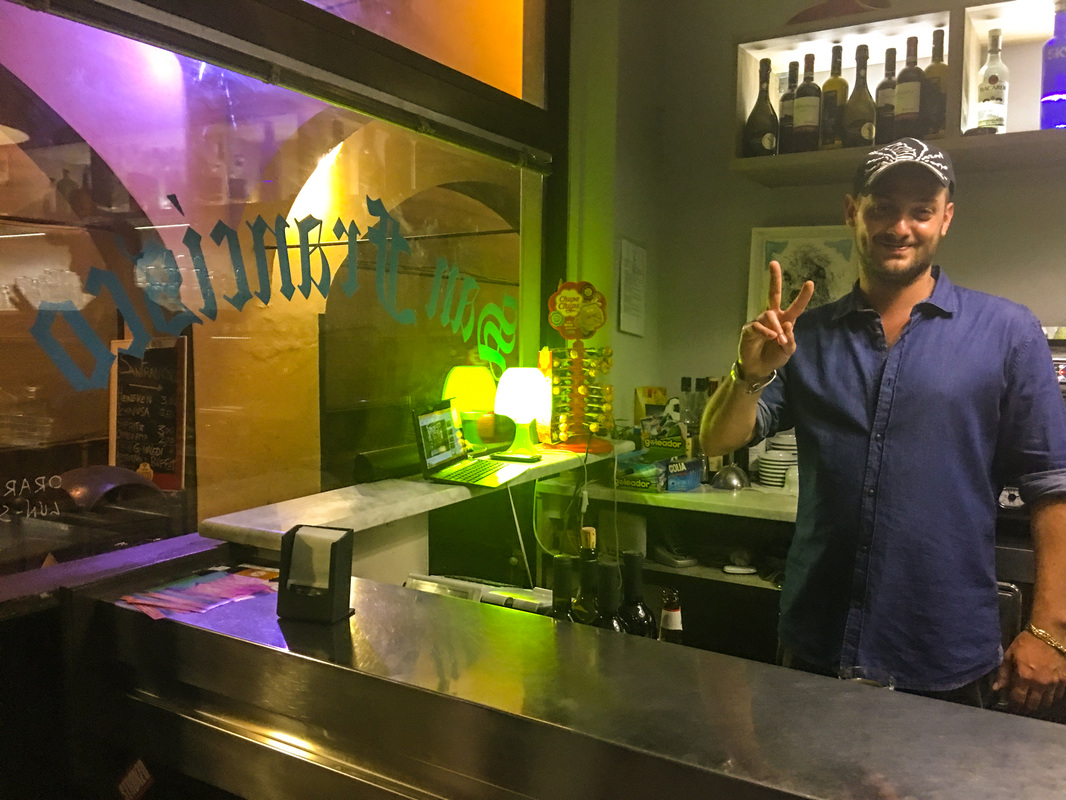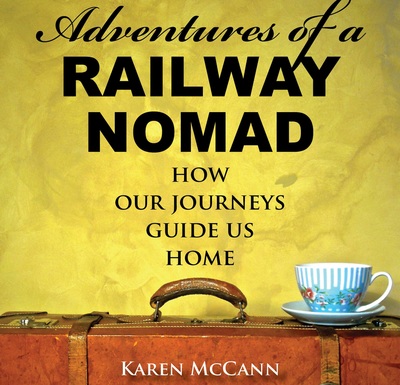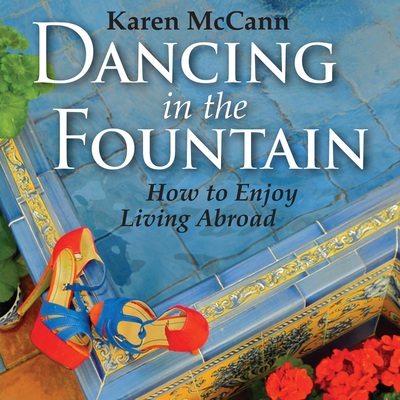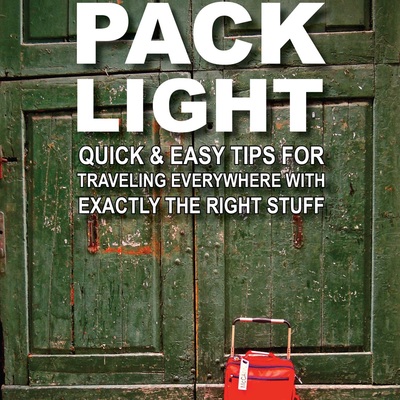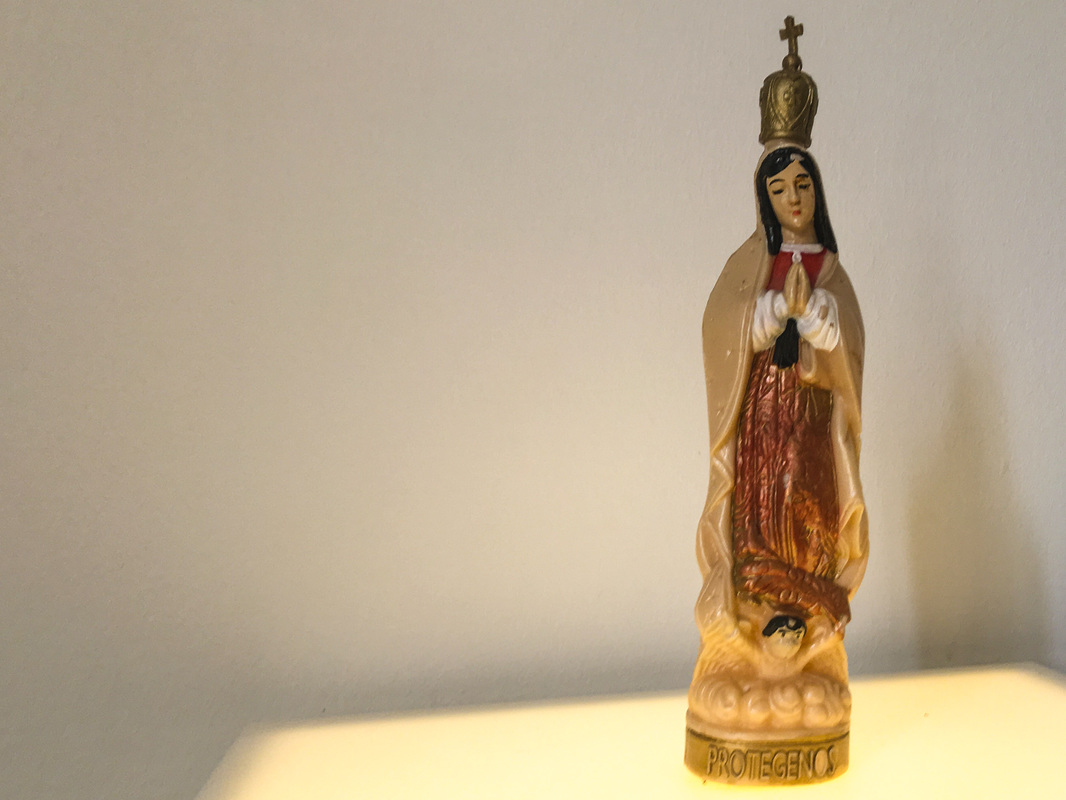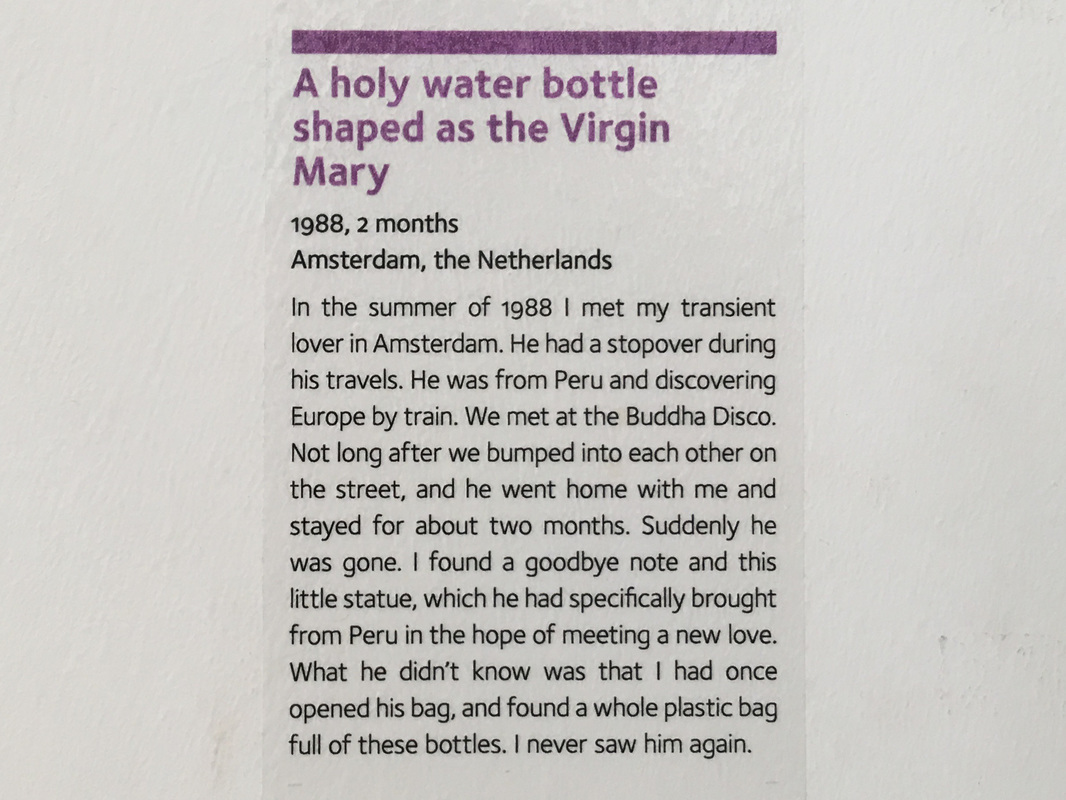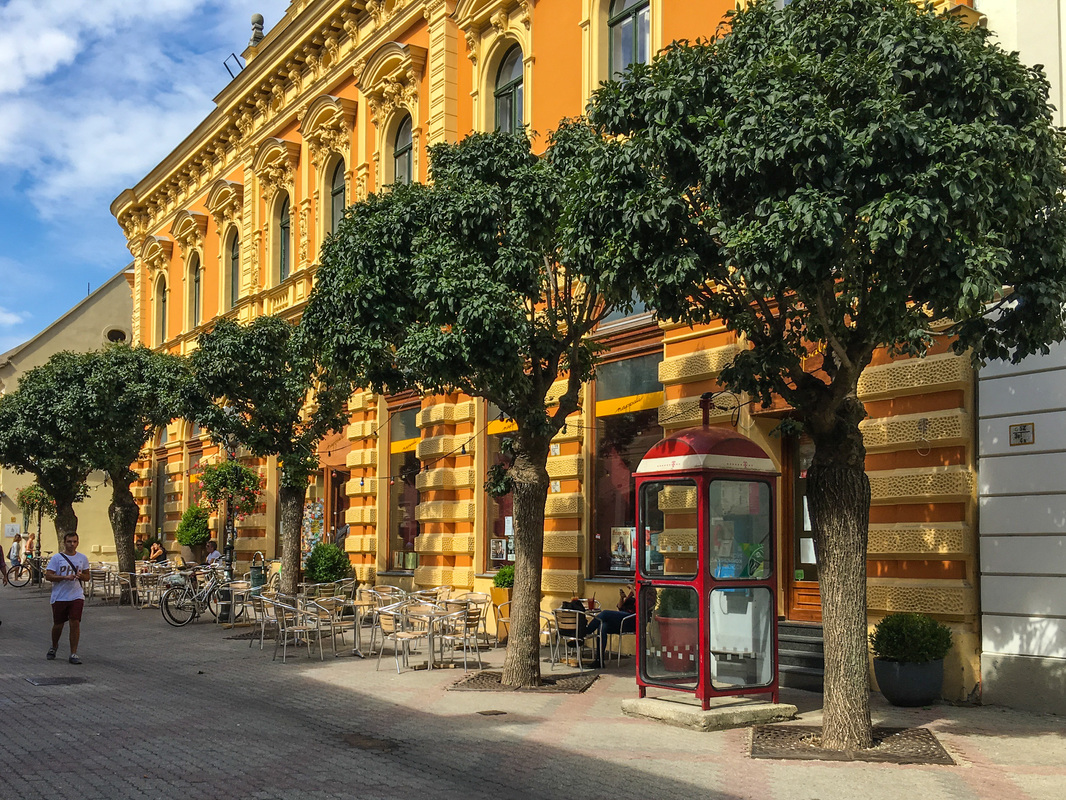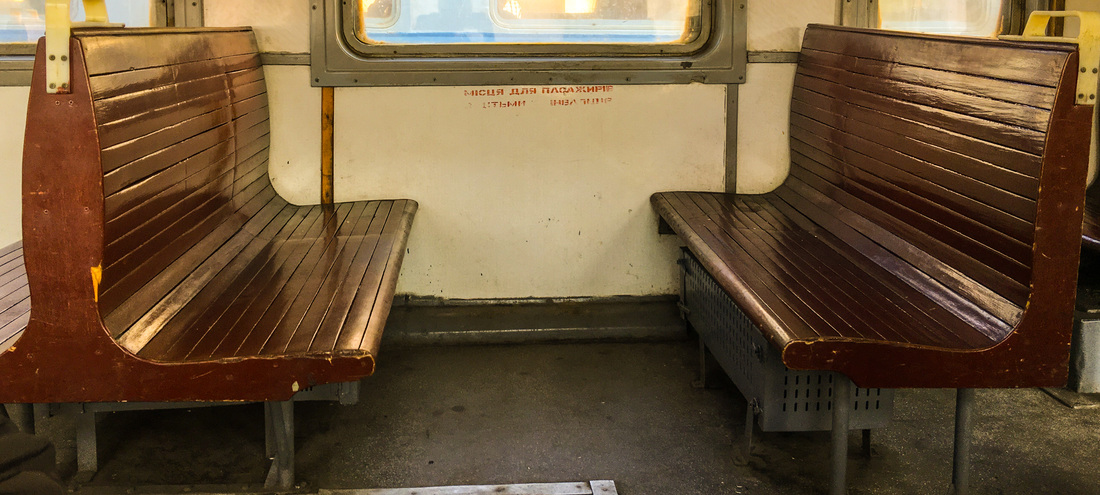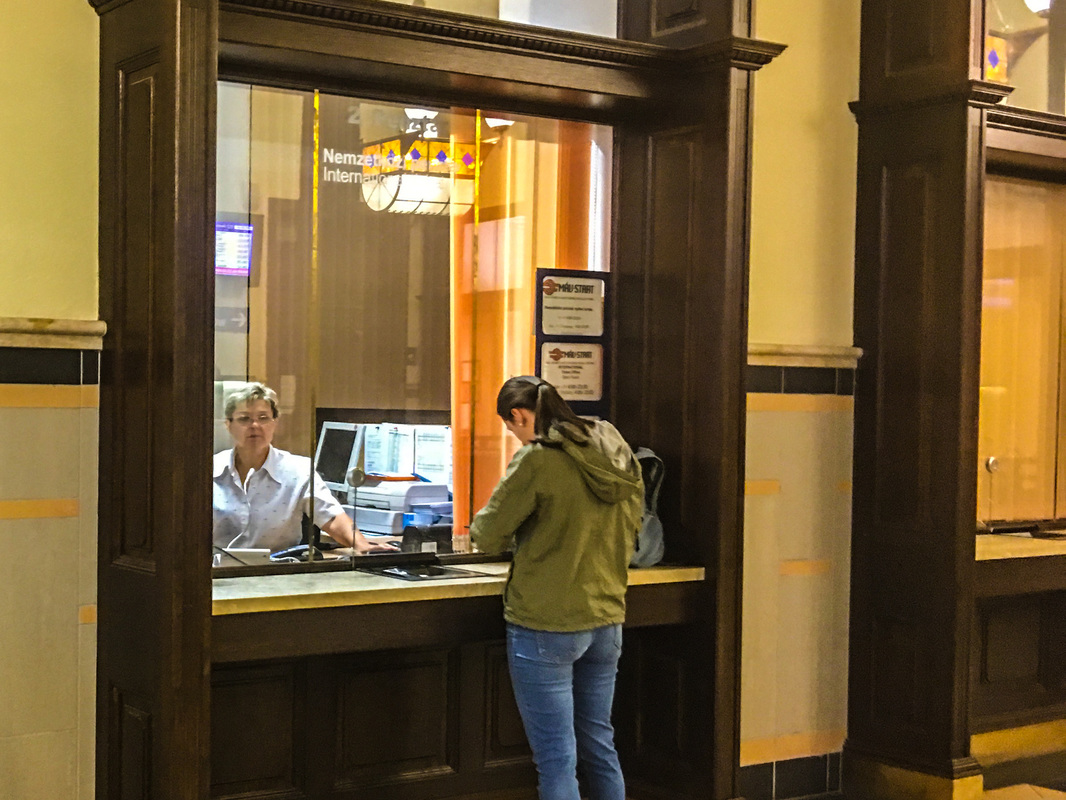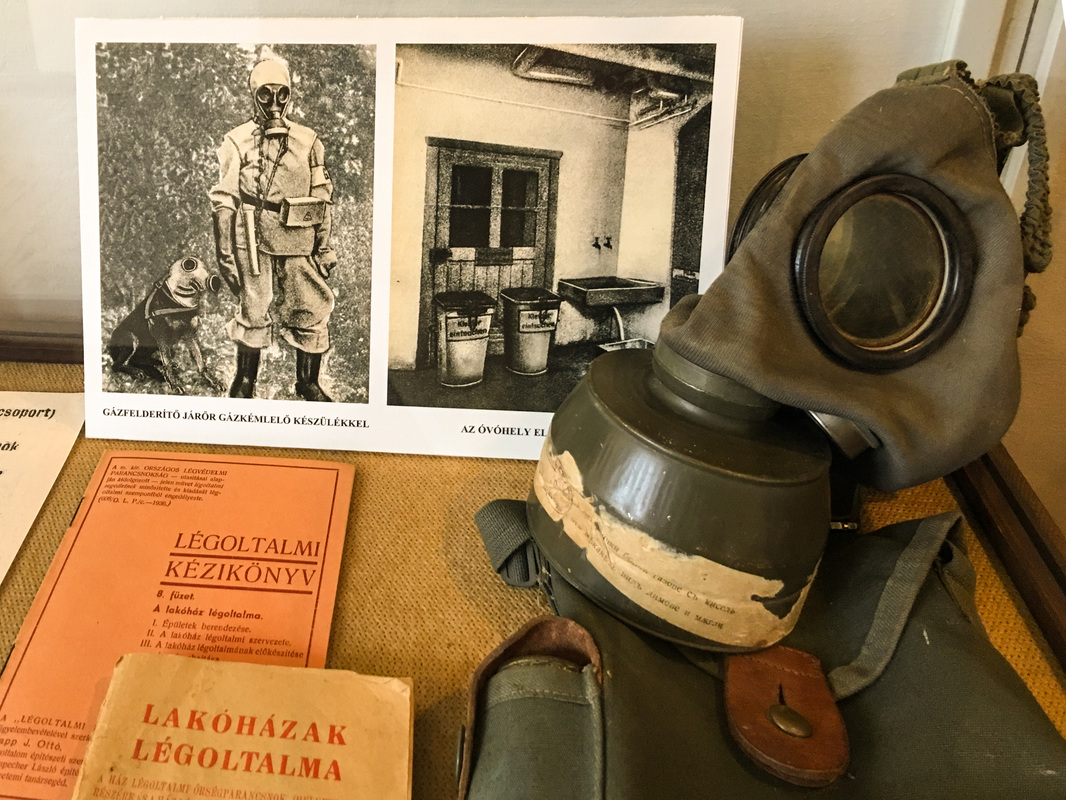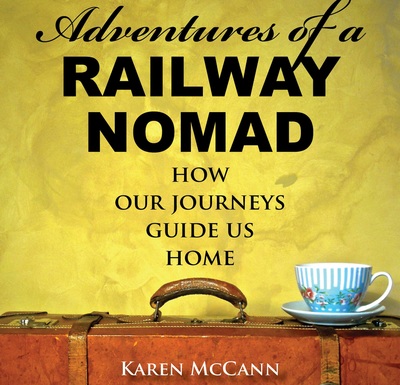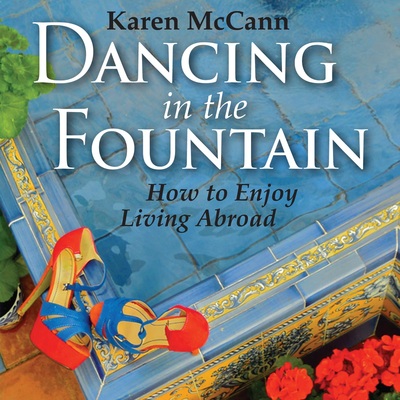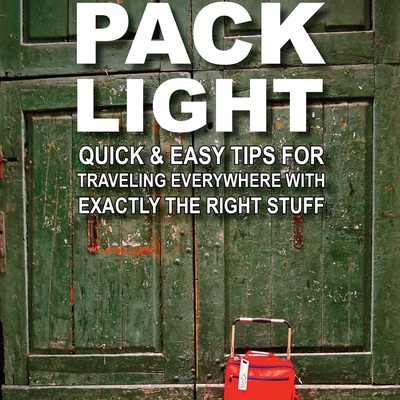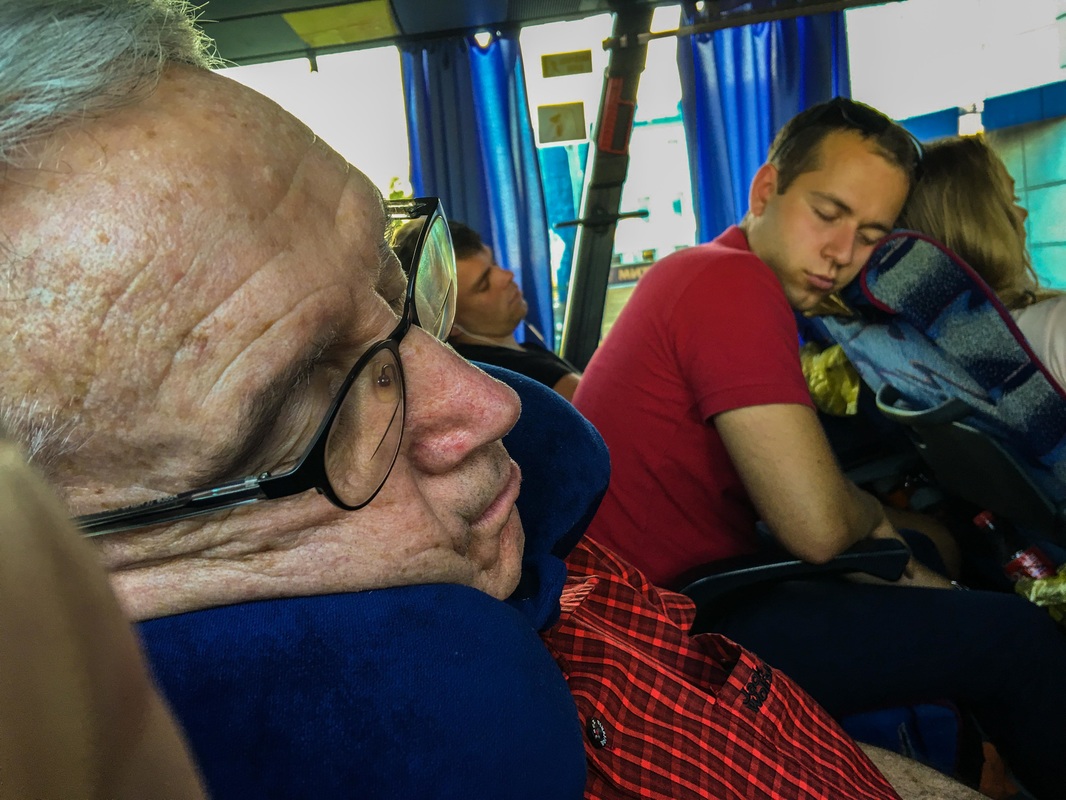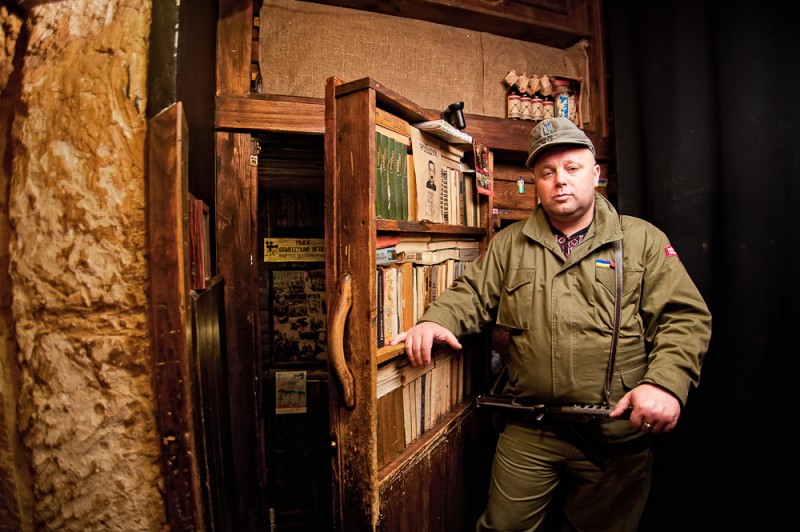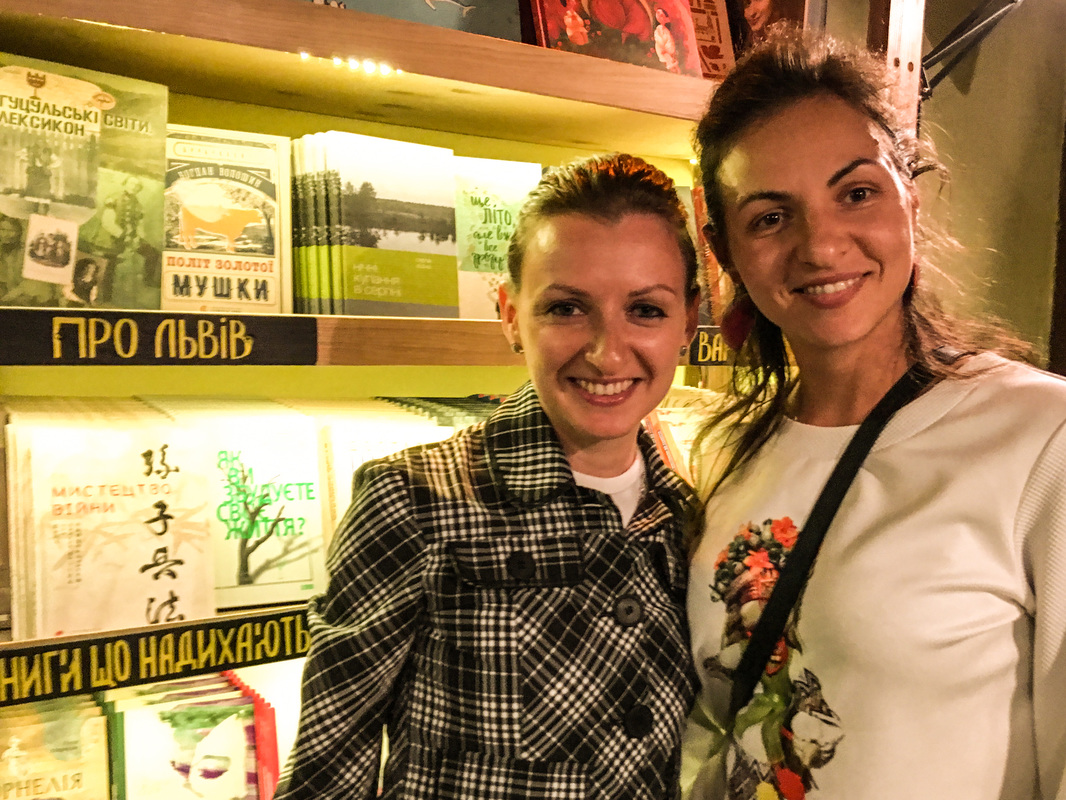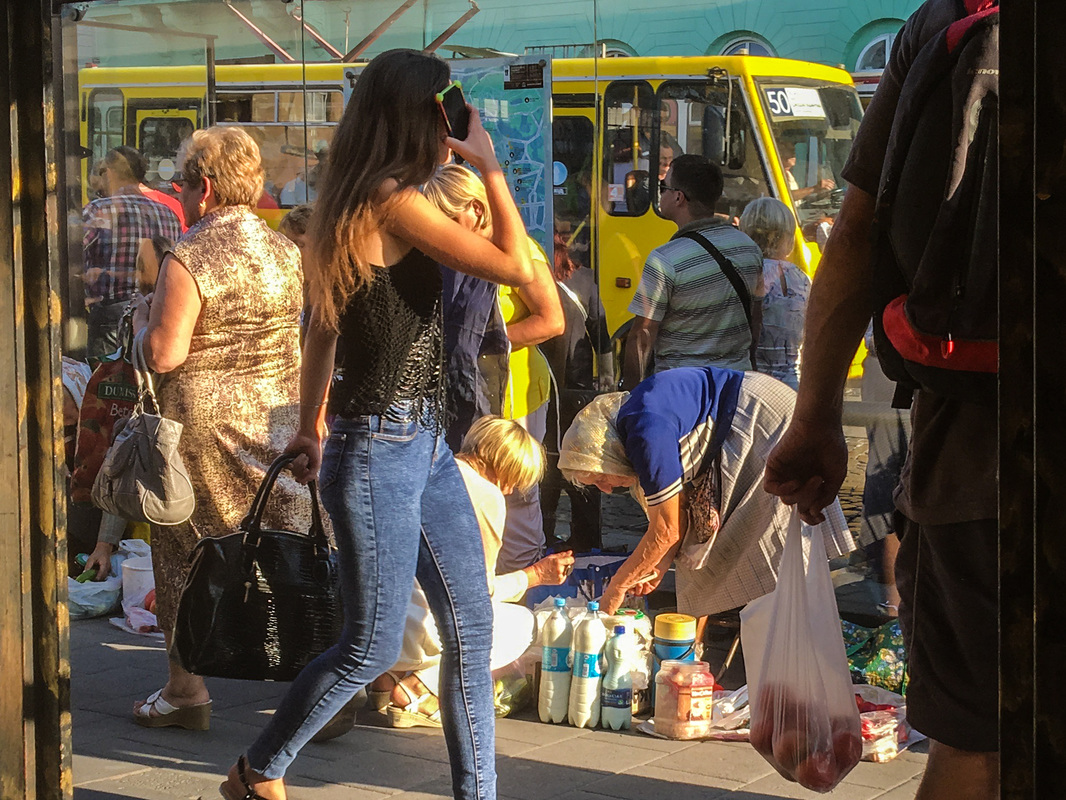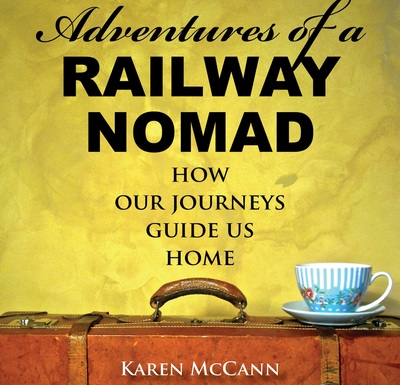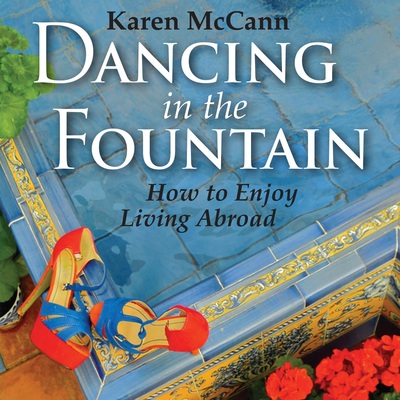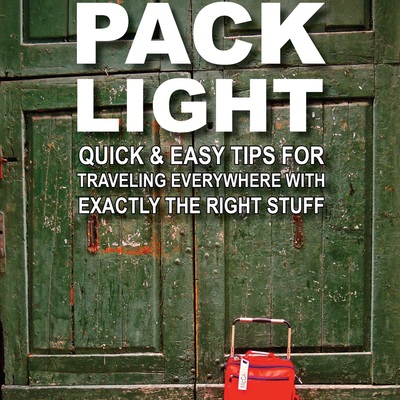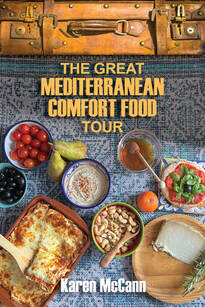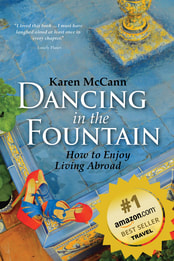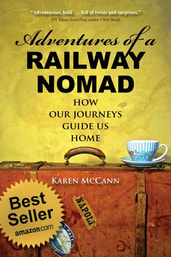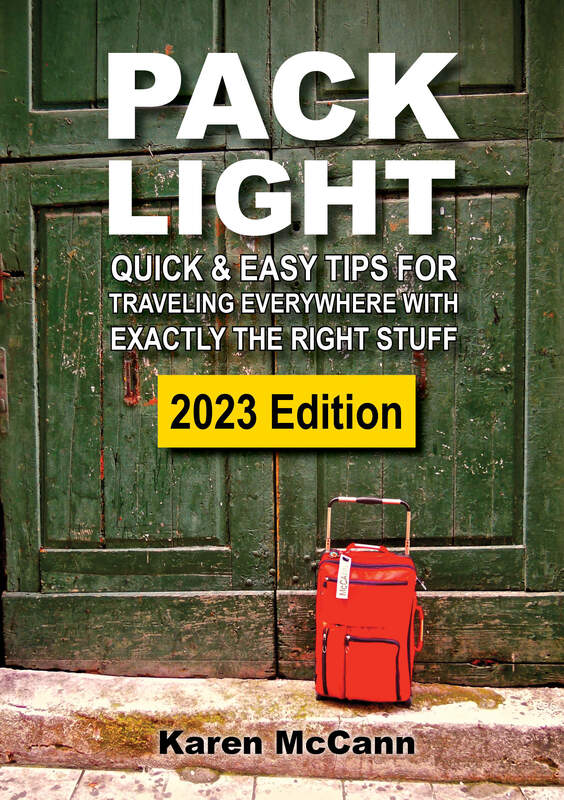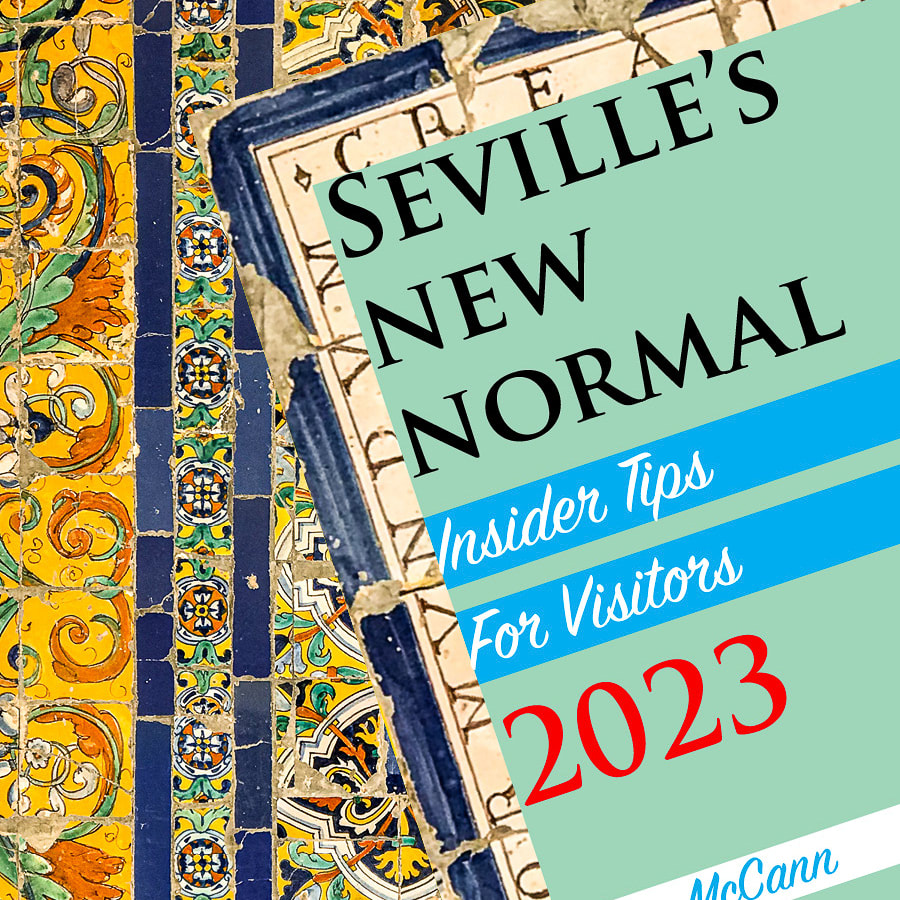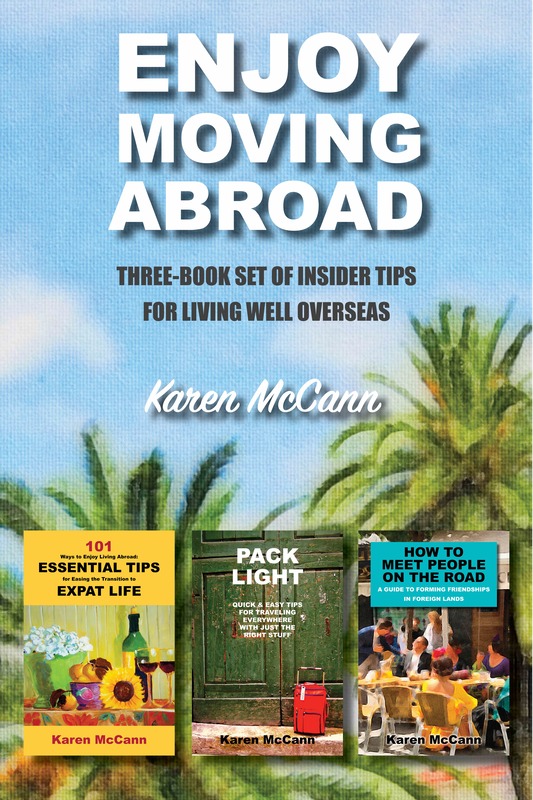|
“Barcelona hotels have gotten ridiculously expensive,” said Rich, thumbing through his hotel-finding app as we planned the final night of our three-month railway journey. “But I have one that’s near the train station and quite reasonable.” Hmmm. Convenient and cheap? What were the odds? “Can I take a look?” I asked suspiciously. I was still trying to shake grisly memories of the Hotel due Mondi in Torino, Italy, which featured 1970s furniture dotted with cigarette burns, floor space approximately one foot larger than the bed, and an air conditioning system that had been turned off for the year despite daytime temperatures hovering near 90 degrees. But when Rich showed me the online photos, the Ciutat del Prat Hotel appeared spacious, attractive and comfortable, for a price that was about half what others were charging. “Book it!” I said. Our first inkling that something was wrong came when we arrived at the Barcelona Sans station and Googled the route to this “nearby” hotel. “Fifteen minutes by taxi!” Rich exclaimed. “Wait a minute. This thing’s out at the airport!” In fact, it turned out to be well past the airport, and as the cabby turned off the freeway, we found ourselves in an industrial zone full of auto dealerships, car part retailers, and a massive cement factory. The Ciutat del Prat was surrounded by empty sidewalks and silent streets; a few blocks away we could see a lone café umbrella with nobody sitting under it. It’s easy to feel dejected on the last night of any trip, but this looked like a profoundly new low for us. The hotel was perfectly comfortable and even nicer than appeared online, but the location wasn't exactly inspiring. We checked in and decided without much enthusiasm that we might as well take a walk and see whatever meager sights the area had to offer. Rounding a corner, we found a few pedestrians, and soon we were surrounded by small clusters of people. Curiously, they were all walking in the same direction. Zombies? Stepford residents? Aliens pulled by a tractor beam? Obviously we had to investigate. We fell in among them, trying to blend. Ten minutes later we found ourselves at the entrance of a spectacular fun fair, with bouncy castles, bumper cars, games of chance, death-defying rides, cotton candy, blaring music, and screams of laughter. The place was jammed, the air sizzling with excitement. “So not quite as boring as we thought,” I said to Rich, grinning. And we plunged in. It was a rousing finish to an amazing trip. We arrived back in Seville the next afternoon and immediately indulged our taste for dive bars by visiting one of our local favorites, Taberna Águilas, raising a glass and rejoicing in our safe arrival home. That was Sunday, and now that we’ve had a few days to catch our breath, Rich has gotten busy tabulating the details of our trip. One of the surprises was that we saved a lot of money by not using Eurail passes. Shortly before we set out, Rich sharpened his pencil and did the math. A Global Pass, which allows unlimited use (with occasional additional fees for overnight or high-speed trains) runs $1814 a month for two people. We figured we could do better, and as it turned out, we bought tickets individually and spent almost exactly that same amount, $1803, for our entire three months of train travel. OUR TRIP BY THE NUMBERS Days on the road: 91 Countries visited: 15 France Holland Germany Sweden Finland Estonia Latvia Lithuania Poland Ukraine Hungary Croatia Slovenia Italy Spain Cities/towns visited: 35 Distance walked: 500 miles / 805 km Trains taken: 30 Buses taken: 4 Ferries taken: 3 Uber cars taken: 2 Taxis taken: 1 Distance covered by vehicles: 4409 miles / 7096 km Total distance traveled (all vehicles plus walking): 4909 miles / 7596 km Number of adventures: countless So what’s next? Today is my 65th birthday, and I am taking a couple of weeks off to celebrate that milestone and the successful completion of our journey. After that I’ll be back to share some of the lessons we learned, describe adventures that I didn’t have room to include in the posts written on the road, and answer any questions you may have about travel, the expat experience, or the American obsession with dive bars and duct tape. In the meantime, thanks for following along on the journey!
40 Comments
“Forget that one,” I said. “It looks charming, the food smells great, and the liquor is top-shelf. Obviously we can’t go there.” We were walking through Trieste, Italy, passing one adorable trattoria after another. Rich gazed longingly at the cozy interiors and clusters of sidewalk tables loaded with fresh pasta, succulent pork, fried fish, and the region’s glorious Barolo wines. “We’re on a quest,” I reminded him firmly. “There’s a dive bar out there, and we will find it.” Tonight we had vowed to track down authentic local options, avoiding the cookie-cutter places offering tourists a predictable, packaged regional food experience and overpriced drinks. The odds were clearly in our favor, because when he’d Googled Trieste that afternoon, Rich had discovered dozens of listings for dive bars. For those of you who may not be familiar with the American term “dive bar,” it refers to a well-worn, unpretentious local place that can be anything from a comfy, no-frills neighborhood pub to the kind of squalid gin joint that requires burning your clothes afterwards. Those of our friends and relatives who gravitate toward the finer things in life tend to abhor places that are dark and dingy with peanut shells on the floor, tattooed pool players, and juke boxes featuring country western hits from 1987. We, on the other hand, find them amusing and were curious to see what Italy had to offer along these lines. You can imagine our disappointment when these so-called “dive bars” turned out to be adorable little taverns. “Don’t these people know what a dive bar is?” complained Rich. “Where’s the smell of stale beer? The neon sign on the fritz? The bar stools held together with duct tape?” Obviously we would have to strike out on our own. It took a while, but eventually I passed a half-open door through which I glimpsed a young woman standing behind a black Formica bar topped with scarred wood. Stepping in, I discovered a large room painted matte black where heavily tattooed young people were moving amplifiers and mopping the floor. “Sorry, we’re closed,” said the bartender. “Oh, too bad,” I said. “We just wanted to stop in for a drink.” And then (a trick I’ve learned in these situations) I just stood there, waiting to see what would happen. “Well, we can sell you a beer,” offered one of the guys. Bingo! 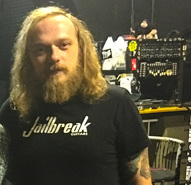 Marco of Tetra Marco of Tetra I explained our quest to the bartender, a Russian known as “Yeah Katerina,” and her boyfriend, Marco. They told me this wasn’t a bar but an alternative music venue called Tetris, run on a volunteer basis by musicians. I asked Marco about his tattoos, and he showed me the one he got in memory of his beloved grandfather, which naturally led to life stories and philosophy. “I know I will never be rich or famous playing the kind of music I play,” said Marco, whose day job involves clerical work in a hospital. “But it’s what I love.” Eventually Yeah Katerina announced, “We need to lock up. Come with us, I’ll show you my friend’s place. It might be a dive bar.” We walked to a modest little place called Viva, where over beer and potato chips we talked politics, archeology, and religion, arguing the merits of meritocracy and whether the Beatles were really that great (yes they were!). It was tremendous fun. And while some sticklers might not consider either of these venues to be true dive bars, they sure delivered a local experience. There was little doubt about the qualifications of our next candidate, the San Francisco in Padova. The bartender was totally friendly, half drunk, and very slightly acquainted with the English language. We pantomimed our desire for beer. He filled a glass with white wine and took a swig. Then he produced beer glasses, filled them to overflowing, levelled the foam with a knife, dunked the base of each glass in water and wiped it clean. It was the most elaborate prep I'd ever seen on a draft. He chatted away, telling us to go see the Giotto frescoes at the nearby Scrovegni Chapel; this seemed so wildly out of character that I began wondering if I should revoke his dive bar status. Then he dropped and shattered his wineglass, poured himself a rum and coke, and became considerably less coherent. Definitely a dive bar. But it wasn’t until we reached Torino that we hit the motherlode. There were a dozen dive bars right in our neighborhood, many identified simply by a neon sign saying “BAR,” all providing cheap beer and a rich cast of local characters. 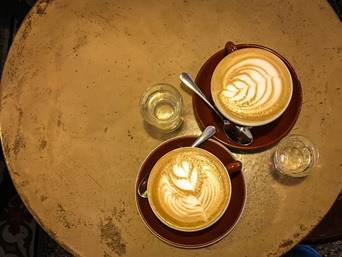 For the morning after... For the morning after... Don’t get me wrong; I enjoy excellent food and up-market drinks as much as the next person. So why am I drawn to dive bars? Because everyone is welcome there. You don’t have to wear fancy clothes, hold down a trendy job, or be able to pay $17 for a glass of wine without blinking. Nobody cares how thin or old you are or what, if anything, you are driving. It’s extremely refreshing. Not all dive bars are quite that friendly, of course, and some are a bit too dodgy even for us diehard fans. But in a world where differences so often divide us, it’s great to know that places exist, maybe right in your neighborhood, where your own unique voice and quirky character will always be a welcome addition to the mix. Cheers. Know a good dive bar anywhere in the world? I'd love to hear about it in the comments below! If you have photos, send them to me at [email protected]. Our current location: Lyon, France Days on the road: 88 Distance covered: 5413 km / 3363 miles Highlights have included zany Amsterdam, the German city of Lübeck on the edge of the Baltic Sea, the Stockholm disaster, the new foodie mecca of Helsinki, Finland, futuristic Estonia, and a kookie visit to Riga, Latvia. We headed south to Šiauliai, Lithuania, where history — and great chocolate — were made. Vilnius — and the tiny Republic of Užupis— taught me about miracles; I learned something new about devils in southern Lithuania and northern Poland. In Warsaw, we learned that nothing is what it seems. We rode the midnight bus to Lviv, Ukraine, and after many adventures there, we moved on to Hungary, with a brief stopover in Budapest and a somewhat too-peaceful rest stop in Pécs. We loved Zagreb (10 points if you know where that is!) and are now making our way back to Seville via Italy and France. To follow our adventures as they unfold, subscribe to my blog, like my Facebook page, and keep checking the map of our journey. 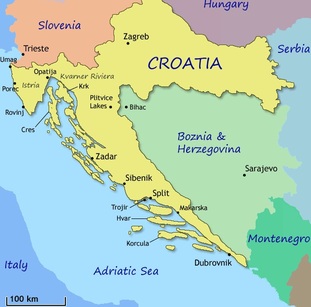 If I say Zagreb, what’s the first response that comes to your mind?
My answer? None of the above. In the past few years, Croatia's capital has transformed itself into one of the most delightful cities in Europe — and one that’s still refreshingly tourist-free. It’s filled with great eateries, lush parks, and the kind of stylish clothing stores that seriously challenge my policy of traveling with minimalist luggage. “You see all these coffee places and small shops,” said my local friend Doris, gesturing to the charming boutiques and cafés around us. “They are all new in the last five years.” Perhaps the best part of Zagreb’s renaissance is the offbeat museum scene. Among the most innovative is the Museum of Broken Relationships, which displays keepsakes from grand passions that have gone down in flames. For example: The museum was, naturally, the result of a romance gone wrong. When local artists Olinka Vištica, and Dražen Grubišić called it quits, they wondered what people are supposed to do with love tokens from relationships now lying in ruins, stuff that’s too significant to throw away and too painful too keep around. Why not put these objects on display, they thought, along with their stories? The first, wildly successful traveling exhibition gave rise to museums in Zagreb and now Los Angeles; the show still goes on the road, and people around the world are invited to donate mementos and anecdotes. (If you’ve got a splitting-up story that deserves a wider audience, here are the contributor’s guidelines.) As an antidote to the angst of the exhibitions, the gift shop reminds us that breaking up may be hard to do, but it can also be funny as hell. “Oh look,” I said to Rich the next day. “There’s a Museum of Illusions. Let’s check that out.” To be perfectly honest, it turned out to be a bit cheesy and far from original, filled with well-worn optical tricks, such as holograms and op art. But some of it was good fun. In our rambles, Rich and I discovered parades, traditional dancers, and venerable second-hand book stores. The food and drink — from markets, dive bars, cafés, and street vendors —ranged from interesting-but-never-again (the house white in Bacchus Jazz Bar) to very good indeed (the sardines at Bistro Amfora). The best meal we had, hands down, was made by a local dentist named Lidija. She had just become EatWith’s first Zagreb host, and Rich and I were her inaugural guests. Joining us at table were her daughter Doris and long-time friend Mladen, who immediately produced a test tube of orange rakija (fruit brandy) and invited us to try it. From that first moment, the evening flowed forward, the conversation rolling around the table as easily as if we had been old friends. Dinner was served on Lidija’s balcony to take advantage of the unseasonable warm weather, known here, Mladen explained, as “old woman summer.” We began with viška pogača, bread topped with olive oil, onions, and anchovies. “The recipe comes from the island of Vis, in southern Croatia,” said Lidija. “Traditionally it is made with a second crust on top, but that is too much bread, I think.” A summer salad of tomato, cheese, and olives followed, and then Lidija brought out the main course, fresh skuša riba (mackerel) cooked to perfection, the fish dense yet flaky, surrounded with organic potatoes. The side dish was a vegetable nobody knew how to translate. “It’s like kale, but it’s not,” said Doris. One of the things I loved best about this dinner was that nobody reached for a phone to look it up; we were having way too much fun to bother with technical details like that. For dessert we had delicious rožata, a cross between flan and crème brûlée, topped with sour cherries soaked in rakija, accompanied by small, sweet purple grapes from Lidija’s garden. 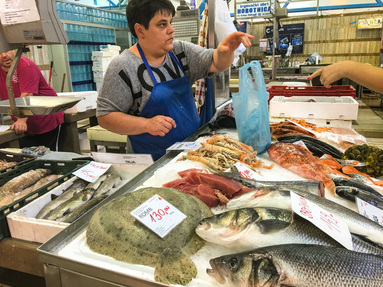 Fishmonger at Dolac Market, a great place to buy fresh skuša riba Fishmonger at Dolac Market, a great place to buy fresh skuša riba I don’t know quite what I expected from Zagreb, but it wasn’t this dazzling kaleidoscope of good fun and good food. Our last night in town, Lidija, Mladen, and Doris took us out to some of their favorite bars for beer and rakija. As we walked through the velvety night, Mladen was explaining some point of local history that “could only happen here in the Balkans.” Wait, what? We were in the Balkans? Somehow I hadn’t tracked that geographical detail at all. Why did it matter? Well, as long-term readers of this blog know, our original concept for the trip was a Balkans-to-Baltics tour lasting five months. When our plans were derailed by family issues requiring our presence in the US, we shortened the trip to three months, started in the north, and accepted the disappointing fact that we wouldn’t have time to work our way as far south as the Balkans. And yet we had. It was a wonderful, gobsmacking realization. So that’s Zagreb for you: a place that’s full of surprises and has a knack for turning tragedy into triumph and strangers into friends. Sure, you can zip through it on your way elsewhere and never give it a second glance. But why would you want to? Days on the road: 81 Distance covered: 4625 km / 2874 miles Highlights have included zany Amsterdam, the German city of Lübeck on the edge of the Baltic Sea, the Stockholm disaster, the new foodie mecca of Helsinki, Finland, futuristic Estonia, and a kookie visit to Riga, Latvia. We headed south to Šiauliai, Lithuania, where history — and great chocolate — were made. Vilnius — and the tiny Republic of Užupis— taught me about miracles; I learned about devils in southern Lithuania and northern Poland. In Warsaw, we learned that nothing is what it seems. We rode the midnight bus Lviv, Ukraine, and after many adventures there, we moved on to Hungary, with a brief stopover in Budapest and a somewhat too-peaceful rest stop in Pécs. We've just left Zagreb, Croatia for Ljubljana, the capital of Slovenia. To follow our adventures as they unfold, subscribe to my blog, like my Facebook page, and keep checking the map of our journey. “Where is everybody?” Rich asked, staring around, mystified. We were wandering through the silent, nearly deserted Hungarian city of Pécs. Allegedly it held a population of 146,000, but at the moment it was doing a pretty good imitation of a ghost town; nothing was moving except for a few scattered pedestrians and a dog rolling over to settle more comfortably into a nap. After a week in vibrant, bustling Lviv, Ukraine, it was like finding ourselves in a sensory deprivation tank. Had we really worked so hard to get to Pécs, only to find there wasn’t much here here? We’d left Ukraine via the southern route, which was good news (we didn’t have to travel by night, as we did going in) and bad (it took two days and five trains). Instead of three hours of pre-dawn traffic jams at two border control stations, all we had to get through was a midmorning passport check and an exhaustive search of our luggage to make sure we weren’t smuggling pharmaceuticals. (I was so glad I’d remembered to carry my prescription medications in their original packaging with my name on the label.) I’ll never forget the moment when the customs inspector was rummaging through my undergarments and discovered the gas mask I’d been given at the Atomic Bunker in Kaunas, Lithuania. Her expression quickly morphed from what the hell? to hey, lady, whatever turns you on. She carefully avoided looking at me as she shoved the gas mask back to the bottom of the bag and signaled I was free to go. I zipped up my suitcase and ran for the train, catching it with minutes to spare. 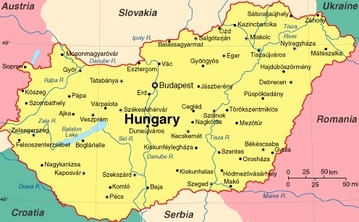 Pécs is the southernmost Hungarian city on this map. Pécs is the southernmost Hungarian city on this map. After 72 days of adventure on the road, Rich and I figured it might be prudent to seek a little rest. And as we soon learned, nobody does restful like Pécs. Lonely Planet (and countless others) describe it as “one of the most pleasant and interesting cities to visit in Hungary.” Thanks to an agreeably mild climate and highly strategic location, over the millennia Pecs has attracted Celts, Romans, Pannonians, early Christians, Turks, Transylvanians, the Republic of Serbian-Hungarian Baranya-Baja, Croats, Nazis, and Russians, to name but a few. Many came as conquerors and stayed to put their architectural stamp on the community, leaving behind a wealth of spectacular old buildings and a deep desire on the part of the community to avoid any more political upheavals. Pécs was officially nicknamed The Borderless City for managing to maintain harmony among such diverse ethnic groups as the Hungarians, Croatians, Swabians, Greeks, and now Serbian refugees. In 1998 its tolerant attitude earned it the UNESCO Cities of Peace prize. “You have to admit,” I said to Rich, “Pécs is peaceful.” “In a crazy-making way,” he agreed. We were back at the train station attempting to change our outgoing tickets, and the relaxed pace of the transaction was stupefying, even for hardened veterans of Spanish bureaucracy, which until now had been my benchmark for human inefficiency. To forestall any difficulties, we’d armed ourselves with written instructions in Hungarian (penned by Gabrielle, our Airbnb hostess) explaining the simple change we wanted to make. The clerk, a kindly middle-aged woman, grew flustered, then concerned, and finally worried that maybe this ought to be kicked upstairs. Ten minutes and three phone calls later, she announced that yes, it could be done, but unfortunately we’d each have to pay the equivalent of $8 more. It took us ages to convince her we were willing to spend the money. And then she began to fill out the necessary forms by hand, carefully adding the appropriate stamps, staples and signatures. The entire transaction took upwards of half an hour, and I really wished I knew enough Hungarian to apologize to the people behind us waiting their turn. Delays are always maddening, of course, but there is also something curiously soothing about being in a place where time doesn’t seem to have the same urgency it does elsewhere. When Rich and I visited the Local History Museum, the attendant appeared delighted — almost stunned — to see actual customers. After laboriously re-installing the adding machine tape so she could print out our tickets, she locked up the building and spent forty minutes guiding us through the exhibits with pantomime and smiles. When she unlocked the front door to let us out, there was — what are the odds? — another customer. He nodded amiably, seemingly not at all put out by having to wait on the doorstep while we had our leisurely private tour. If this was the USA, I could only imagine the impatience and complaints, if not actual lawsuits, that would ensue. That night our Airbnb hosts invited us for dinner in the garden, and we lingered past dark over a hearty, delicious tomato, paprika, and sausage stew. That's when it occurred to me that I was finally learning to appreciate Pécs. At first, after more than ten weeks of vigorous forward momentum, the abrupt change of pace caused me acute mental whiplash. But I now realized how lucky I was. How often do you find yourself in a place where time isn’t of the essence, and taking proper care of a stranger is the most important thing on the agenda? 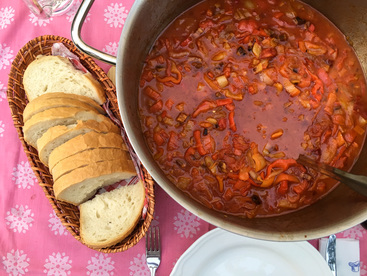 Delicious dinner prepared by our Airbnb hosts in Pécs Delicious dinner prepared by our Airbnb hosts in Pécs Days on the road: 76 Distance covered: 4508 km / 2801 miles Highlights have included zany Amsterdam, the German city of Lübeck on the edge of the Baltic Sea, the Stockholm disaster, the new foodie mecca of Helsinki, Finland, futuristic Estonia, and a kookie visit to Riga, Latvia. We headed south to Šiauliai, Lithuania, where history — and great chocolate — were made. Vilnius — and the tiny Republic of Užupis— taught me about miracles; I learned about devils in southern Lithuania and northern Poland. In Warsaw, we learned that nothing is what it seems. We rode the midnight bus Lviv, Ukraine, and after many adventures there, we moved on to Hungary, with a brief stopover in Budapest and a rest in Pécs. We're on the move again, having just arrived in Zagreb, Croatia. To follow our adventures as they unfold, subscribe to my blog, like my Facebook page, and keep checking the map of our journey. YOU MIGHT ALSO ENJOY 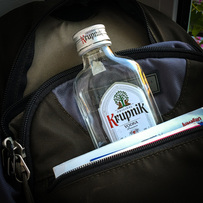 Midnight had come and gone but our bus had not. So there Rich and I sat, in the dimly lit bus station of Lublin, Poland, wondering if our Ukrainian adventure was over before it even began. All through Poland we’d seen ads for glamorous new buses going directly to Lviv, Ukraine instead of following the convoluted railway route that entailed many extra hours of travel and a 3:40 AM train change with just 18 minutes to make the connection (and good luck with that!). The ads showed plush seats, individual video screens, food service, and a stewardess. Of course, the fine print noted that not all buses in the fleet met these standards. Needless to say, ours — when it finally lumbered in some 40 minutes late — proved to be one of the old models, jammed with groggy young Polish and Ukrainian backpackers. “Here,” said Rich as we wedged ourselves into our places. “Have some Vitamin V.” Unable to purchase a small bottle of gin, his usual remedy in such situations, Rich had settled for some rather dubious Polish vodka. We each took a swig to brace ourselves for the long night of fitful sleep and endless border crossings. Now that I’ve gotten to know Ukraine a bit better, I realize that this was the perfect introduction to a country that has a positive genius for clandestine drama. I’d heard a lot about Lviv’s magnificent architecture, great restaurants, and lovely parks, but no one had mentioned its love of mystery or the inspired lunacy of its underground bars. One night our Ukrainian friend Tania led us down an unmarked passage and pounded on an anonymous wooden door. The door opened a crack, revealing a scowling guard in combat fatigues, a gun slung over his shoulder. Guard: “Slava Ukraini!” (“Glory to Ukraine!”) Tania: “Geroyam slava!” (“Glory to its heroes!”) Guard: “Moskal’ee Ye?” (“Are there any Russians among you?”) Tania: “Nee-ma!” (“None!”) “Dva Amerykantsya.” (Two Americans.) The guard shrugged, opened the door, and handed around thimble-sized metal cups, into which he sloshed medovukha (a sweet, mead-like cousin of vodka). We drank up and he let us pass. Stumbling down twisting stairs, we entered Kryjivka, a labyrinthine underground bunker decorated with old military paraphernalia, a tribute to the Ukrainian Insurgent Army that fought the Nazis, Poles, and Soviets. A very young uniformed soldier sat nearby drinking his way steadily through an enormous vat of beer; I wondered if he’d be on his way soon to real battles on the Eastern Front. “More medovukh?” Tania asked me. You bet. Quirky theme establishments abound in downtown Lviv. Tania pointed out the coffee house with the underground caverns made into a “coffee mine,” the masochists café (Leopold Von Sacher-Masoch, for whom masochism is named, is a native son of Lviv), the restaurant you enter through what appears to be some guy's apartment, the one where you’re presented with an outrageous bill and have to negotiate your way out of it, and a new bar selling nothing but a blood-red a cherry liqueur with the motto “And she will say ‘yes.’” The next night we had dinner with Tania and her cousin Marya, and the conversation ranged over Lviv’s vibrant street life, the tremendous outpouring of creativity in local art, the burgeoning food and coffee culture, and music. Aida was kicking off the fall opera season on Friday, and at Tania’s urging we’d bought tickets. In fact, we had splurged on the most expensive seats: $15 each. Naturally the talk also turned to the economy, politics, and the nation’s future. “Are Ukrainians optimists or pessimists?” I asked them. “They are realists,” said Tania. “They are survivors,” said Marya. I instantly recalled the tiny street market at the city’s central bus stop. Every day two dozen or so women, many quite advanced in years, arrived just ahead of the evening commuters and set out their wares on tiny patches of sidewalk: a kilo of carrots, two dozen cucumbers, a gallon jar of raspberries, a few round white lumps of homemade cheese. I remembered one who had nothing to offer but a dozen eggs. How did she survive? 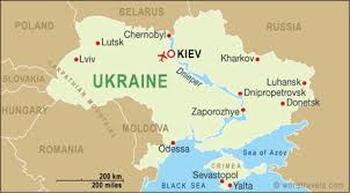 “How much would a woman make selling a dozen eggs?” I asked. “She will have a pension equal to fifty dollars a month,” Marya said. “She probably has a garden and chickens who peck their own food from the ground, so producing the eggs costs nothing. She will sell them for maybe ten cents each; twice what you’d pay in a supermarket. But the quality is so much better; the yokes are really yellow!” “Do you find people in other countries have a lot of misconceptions about Ukraine?” I asked. Both cousins rolled their eyes. “People think we are Russian,” said Tania in exasperation. “To many Americans, we’re just ‘Europe,’” Marya added. “Or they say, ‘Ukraine?’” Tania mimed a sympathetic shoulder pat. “So sorry.” And we all laughed. Because despite the country’s rough past and uncertain future, Lviv today is clearly a place you’d be lucky to call home. 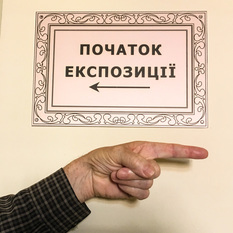 By now we've been on the road just over two months and have covered 3760 km / 2336 miles. Highlights have included zany Amsterdam, the German city of Lübeck on the edge of the Baltic Sea, the Stockholm disaster, the new foodie mecca of Helsinki, Finland, futuristic Estonia, and a kookie visit to Riga, Latvia. We headed south to Šiauliai, Lithuania, where history — and great chocolate — were made. Vilnius — and the tiny Republic of Užupis— taught me about miracles; I learned about devils in southern Lithuania and northern Poland. In Warsaw, we learned that nothing is what it seems. We are currently enjoying Lviv, Ukraine. To follow our adventures as they unfold, subscribe to my blog, like my Facebook page, and keep checking this page for updates of the map. |
This blog is a promotion-free zone.
As my regular readers know, I never get free or discounted goods or services for mentioning anything on this blog (or anywhere else). I only write about things I find interesting and/or useful. I'm an American travel writer living in California and Seville, Spain. I travel the world seeking eccentric people, quirky places, and outrageously delicious food so I can have the fun of writing about them here.
My current project is OUT TO LUNCH IN SAN FRANCISCO. Don't miss out! SIGN UP HERE to be notified when I publish new posts. Planning a trip?
Use the search box below to find out about other places I've written about. Winner of the 2023 Firebird Book Award for Travel
#1 Amazon Bestseller in Tourist Destinations, Travel Tips, Gastronomy Essays, and Senior Travel
BLOG ARCHIVES
July 2024
CATEGORIES
All
|
